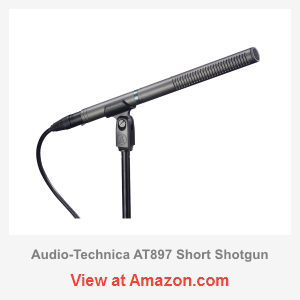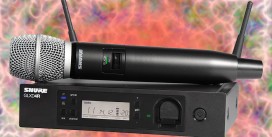Audio-Technica AT897 is another 11” short shotgun that is very similar to NTG-2. Both mics have identical size and construction and both cost roughly the same money. The quality is very similar too but they have slightly different sound or call it “tone”. Although this isn’t obvious from the frequency pattern, NTG-2 tends to add some mud on low end, especially when miked indoors. On the other hand, AT897 sounds brighter but tends to get more brittle and fatiguing when miked in field.
Sound & quality
This mic is not perfect but it sounds amazing for the price! Even though this is only an entry model, it can still be used in production without sacrificing the quality. In fact, Audio-Technica AT897 has been a go-to model for many videographers for over a decade, and up to day, things did not change much – the great mic is still a great mic. In sound recording and especially videography, the final outcome will anyway depend more on the skill and experience of operator rather than the price of your equipment.
The frequency pattern of AT897 isn’t as flat as of NTG-2 though it’s really close. In terms of tonality, NTG-2 is slightly more accurate, however both mics sound equally rich and detailed and in many situations, it will be hard to tell one from another. AT897 is less prone to noise; on the other hand, NTG-2 offers a slightly better sensitivity. Technically, they are both great but neither is best. As they are also both industry standard shotguns, a lot of videographers have had them both but their opinions are always clashing on this subject.
If you are struggling with your choice between NTG-2 and AT897, I would simply suggest sticking with producer that you trust most. If you are a fan of RØDE – go with NTG-2. If you love Audio Technica – AT897 will probably make more sense. Either way, the differences among the two are only slight and with a bit of EQ and positioning there will be none. An average consumer probably won’t even notice the difference if you compare it with some knowingly better and more expensive units.
Design and build
 As been noted earlier, the design is almost identical to that of NTG-2. The mic has a low frequency roll off switch placed a couple millimeters below the surface, so it requires something like a hairpin in order to access. The on/off switch is absent as well so in order to converse the battery, you will have to unscrew and unplug it. When it comes to durability, Audio-Technica AT897 is quite sturdy and it is not easy to break even if accidentally dropped. The manufacturer also provides a 5 year limited warranty.
As been noted earlier, the design is almost identical to that of NTG-2. The mic has a low frequency roll off switch placed a couple millimeters below the surface, so it requires something like a hairpin in order to access. The on/off switch is absent as well so in order to converse the battery, you will have to unscrew and unplug it. When it comes to durability, Audio-Technica AT897 is quite sturdy and it is not easy to break even if accidentally dropped. The manufacturer also provides a 5 year limited warranty.
The windscreen included in the package has a very cheap look and it hardly does its job. Shotguns are very sensitive to all sorts of handling, vibration and wind noises and that piece of foam is simply not enough, unless for a completely calm weather. If you film live events, you will put your recordings at risk without having a decent windscreen. Since AT897 has the same dimensions, you can once again use the RØDE WS6 windsock, it’s great and will fit it perfectly.
Who should use it
Audio-Technica AT897 is ideal for beginner videographers who need an affordable but quality directional microphone. As a short shotgun it is relatively easy to use and it’s good for many occasions – such as booming, close miking and behind the camera. If working on smaller projects, you may not even need to upgrade as long as it’s working. Before considering an upgrade to a professional model, I would advise to master your technique and experiment with digital recorders, such as Zoom H4n or Tascam DR-40.
If you still believe you require more quality, only then would I suggest investing in professional gear. This is because a professional short shotgun on average costs around $1,000 but it does not offer any substantial difference especially if used incorrectly. It will certainly have better noise parameters, more expensive components with a top-notch capsule – but still essentially the same mic. Do not overthink it: Audio-Technica AT897 will be an excellent, quality choice as a starter and a budget saver for you.
Pros
|
Cons
|









